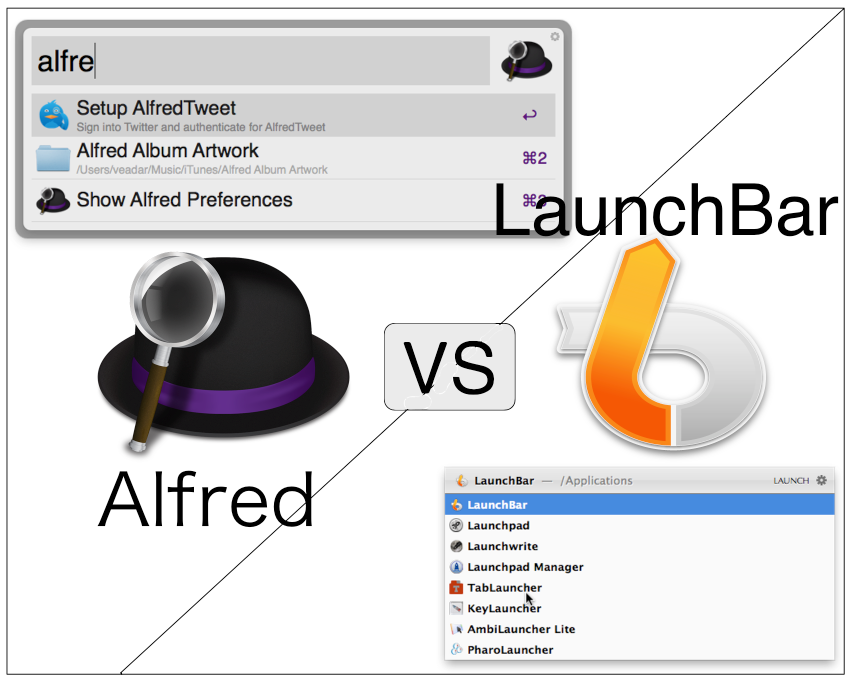
I've made workflows that are as simple as file actions to quickly send a file to an app to full-fledged mini-apps that query APIs, process data, return an array of actionable responses, and then can produce multiple forms of output. But there's such power and flexibility in them that once you get in there and start making some for your workflows, the power is fantastic.
#Alfred app vs launchbar how to
It's hard to just "sample a bunch" because you'll forget how to invoke them. I think one of the biggest challenges with Workflows are, however, what you said. Its file buffer is easy to use, it has a "good enough for 95% of people" text snippet module with variables, its mini-player for music is good for quick commands, and the real guts of it, Workflows, are amazing. It's fast, which is good, but it doesn't index Spotlight metadata and for simple operations can suffer from some of what you mention.īut it can do so much more, and a lot of it is more intuitive than I've found in other applications.

But for me, the raw power of Alfred more than makes up for it.Īs purely a launcher, Alfred is okay.

I do think that for some operations, how you describe is more intuitive. I think that ultimately it's down to how your brain works. I know Alfred is immensively popular, so I'm asking myself whether I'm the only one having a big gripe about this behaviour. Then I press Tab and get to set the verb: "Remind me to ", "Send as e-mail", "Send as sms", "Google ". Quicksilver and Launchbar both get this right, allowing workflows to start by typing the object: "Buy Milk". Was it "Remind "? "Note "? "Create "? "Remember "?). Alfred interrupts this process by forcing me to first recall the specific command that I want to execute on the thought I'm forming. When I get a thought that I want put into words ("Buy milk"). Hoping for some good input, I want to verbalise where I think Alfred goes wrong: I did my master's thesis on cognition and how user interfaces affect working memory. Installed, got disappointed, installed Quicksilver, got disappointed and installed Launchbar, which turned out to be only half a dissapointment. Some quick research dubbed Alfred the new kid on the block. I still miss the workflow part and thought I'd look into today's alternatives. Subscribers get access to an exclusive podcast, members-only stories, and a special community.I'm installing my new MacBook and came to think of Quicksilver - a workhorse some 15 years ago, sent away once Spotlight entered into my life. If you appreciate articles like this one, support us by becoming a Six Colors subscriber. It’s still early days, but the progress so far has been impressive. (Yes, there’s also a LaunchBar Action by Christian Bender that will automatically add a Run Shortcut action to LaunchBar-and it automatically indexes your list of shortcuts, so every single one is available without needing to add it to the Dock.)īit by bit, it’s exciting to see ways that Shortcuts is starting to reach out into how I use my Mac. John’s example uses Alfred, but I was able to add that path to LaunchBar, and it worked too.
#Alfred app vs launchbar code
(Unlike AppleScript scripts or Automator actions, the actual code of shortcuts doesn’t reside in the file-it’s safe in your Mac’s Shortcuts database.) If you use any app launcher that is capable of indexing ~/Applications, you can save shortcuts there and they’ll be available for quick launching.
#Alfred app vs launchbar mac os x
While there’s also an Applications folder inside your user folder-and in the early days of Mac OS X there was a real debate about where best to install software on a Mac-it’s largely unused.īut that’s where Shortcuts saves a link to your shortcut. Now, what most Mac users think of as the Applications folder lives at the top level of your Mac’s boot drive. At that point, not only will the shortcut appear in your Dock, but it will also be saved to ~/Applications.

It’s a bit hidden-you need to select or open a shortcut and then choose Add to Dock from the File menu. Strangely, while on iOS you can save a shortcut as a home-screen icon, there’s no option on the Mac to save a shortcut into the file system… or is there?Īs John wrote (and then expanded on in the latest MacStories Weekly), Shortcuts on Mac also lets you add any shortcut to the Dock. Shortcuts show up in a few places in macOS Monterey: in the menu bar, in the Services menu, and in Finder Quick Actions. This week, thanks to an article by John Voorhees at MacStories about integrating Shortcuts with the Elgato Stream Deck, I discovered an incredibly useful tip about Shortcuts integration on the Mac. Tip: Make Shortcuts into Mac Apps (sort of)


 0 kommentar(er)
0 kommentar(er)
